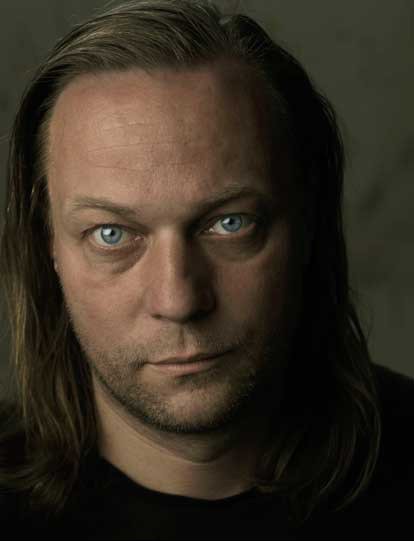Two exhibitions
dal 28/11/2012 al 26/1/2013
Segnalato da
28/11/2012
Two exhibitions
NBK Neuer Berliner Kunstverein, Berlin
Anja Kirschner and David Panos collide choreographed movements of labor, geometric proofs, and archaeological and contemporary everyday objects, contrasted and compiled into a reflection on economy and the prehistory of industrial labor. Jens Ziehe features his artist's portraits from more than 20 years, ranging between life-and magazine style, photojournalism and classic portraiture, including Franz Ackermann, Olafur Eliasson, Valerie Favre, Dan Graham, Mike Nelson, and Thomas Scheibitz.

Anja Kirschner and David Panos
December 1, 2012 – January 27, 2013
Curators: Sophie Goltz, Kerstin Stakemeier
Neuer Berliner Kunstverein shows new work by Anja Kirschner (b. 1977 in Munich) and David Panos (b. 1971 in Athens). In recent years, Kirschner and Panos have established themselves internationally, taking a significant position in artist video and were awarded the 2011 Jarman Award. Most recently their work has been exhibited in locations including: Artist Space, New York (2012), Liverpool Biennial (2012), Staatsgalerie Stuttgart (2011) and Kunsthall Oslo (2011).
Their video Ultimate Substance (2012, 34 min), presented for the first time in Germany, will be staged in a setting of sculptural elements. The film departs from the hypothesis that the advent of coinage, which first emerged in ancient Greece, led to the fundamental division between sensual and abstract forms of experience. The metaphysical outlook of Greek philosophy and mathematics can be seen as corresponding to the abstract experience of monetary exchange.
Ultimate Substance was filmed in and around the Numismatic Museum of Athens and in Lavreotiki, a nearby mining district, where industrial scale extraction provided the silver on which the classical Athenian city-state was founded. Abandoned in Roman times, the mines were re-discovered in the 19th century making Lavrio the first factory town of the modern Greek state. In the 1970s the local mining industry was again dismantled. Today the factory ruins house a museum on mining history.
Jumping between images of antiquity and present-day crisis ridden Greece, the film is neither documentary, nor a narrative work. Instead, it consists of fragmented pictorial quotes that are assembled and shuffled through hard cuts, emphasized with concrete sound editing.
The artists collide choreographed movements of labor, geometric proofs, and archaeological and contemporary everyday objects, contrasted and compiled into a reflection on economy and the prehistory of industrial labor. Kirschner and Panos propose the introduction of coinage as crucial to the rise and development of the Western philosophical tradition and science, which even today dominates the way in which we comprehend the world.
Publication
The exhibition is accompanied by an artist’s book with an essay by Richard Seaford, a text collage by Anja Kirschner and a foreword by András Pálffy, published by Revolver Publishing, Berlin.
Program
Thursday, December 6, 2012, 7 pm
Video Becomes Display Becomes Situation
Gregor Stemmrich (Prof. Art History, Director Kunsthistorisches Institut, Freie Universität Berlin) in conversation with Kerstin Stakemeier (Juniorprof. Media Theory and Visual Studies, Akademie der Bildenden Künste Munich)
Thursday, December 13, 2012, 6 pm
Exhibition talk with Sophie Goltz (n.b.k. curator)
Saturday, January 26, 2013, 6 pm
Art as a Form of Crisis (Part 1): The Aesthetics of Money
Introduction by Stewart Martin (Senior Lecturer Modern European Philosophy, Aesthetics and Art Theory, Middlesex University London; contributing editor Radical Philosophy, London), followed by an artist talk with Anja Kirschner and David Panos (artists, London / Athen, and Stewart Martin, moderated by Sophie Goltz
In English language
Sonntag, 27. Januar 2013, 16 Uhr
Art as a Form of Crisis (Part 2): Money in the State of Crisis. The Example of Greece
Discussion and workshop* with Dimitra Kotouza (Blaumachen, Athens/Thessaloniki; contributing editor Mute Magazine, London), Michael Heinrich (mathematician and political scientist, contributing editor Prokla. Zeitschrift für kritische Sozialwissenschaft, Berlin), Nikos Arvanitis (artist und musician, Athens) and with Freundinnen und Freunde der klassenlosen Gesellschaft (Berlin), moderated by Kerstin Stakemeier (co-curator Ultimate Substance)
In German and English language
*Limited places, for information and registration: nbk@nbk.org
Sonntag, 27. Januar 2013, 20 Uhr
A Victim Of Society
Concert
----
Jens Ziehe
December 4, 2012 – January 25, 2013
Curator: Marius Babias
Jens Ziehe (b. 1966 in Eckernförde) has been working as a freelance photographer in Berlin since 1989. He has studied Photography at the renowned Lette-Verein in Berlin from 1987 to 1989.
In the early stages, Ziehe most of all worked for newspapers and magazines and was particularly regarded as a photographer of the emerging arts scene in Berlin of the 1990s. He now works for museums, galleries, private collections, artist’s studios and other institutions, including: Deutsche Guggenheim, Hamburger Bahnhof, Neue Nationalgalerie, Neuer Berliner Kunstverein, Berggruen Collection, Hoffmann Collection, TBA 21, neugerriemschneider Gallery, Sprüth Magers Gallery, Barbara Weiss Gallery, Johnen Gallery, Franz Ackermann, Willem de Rooij, Olafur Eliasson, Isa Genzken, Sharon Lockhart, Jonathan Monk, Thomas Scheibitz, and Simon Starling.
Out of his extensive oeuvre Ziehe presents, in his exhibition at n.b.k.’s Showroom, artist’s portraits from more than 20 years, ranging between life- and magazine style, photojournalism and classic portraiture, including Franz Ackermann, Olafur Eliasson, Valérie Favre, Dan Graham, Mike Nelson, and Thomas Scheibitz.
Image: Monica Bonvicini, 2012, Photo: Jens Ziehe
Opening: Friday, November 30, 7pm
Neuer Berliner Kunstverein
Chausseestrasse 128 / 129 - 10115 Berlin
Tuesday—Sunday 12—6 pm
Thursday 12—8 pm
The exhibtion will be closed from December 24 to 26, 2012 and on January 1, 2013.
Admission free



